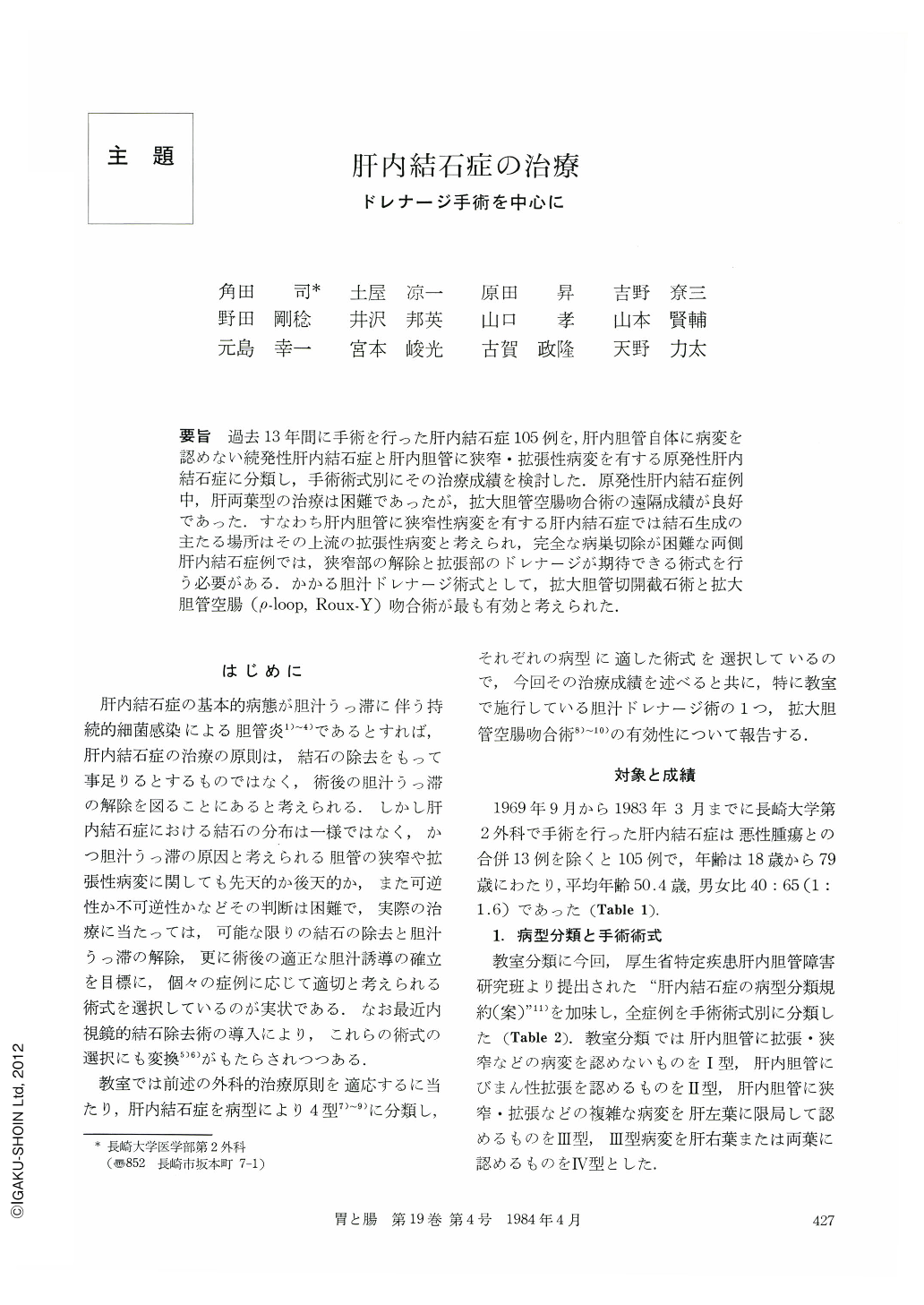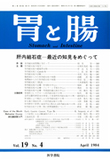Japanese
English
- 有料閲覧
- Abstract 文献概要
- 1ページ目 Look Inside
要旨 過去13年間に手術を行った肝内結石症105例を,肝内胆管自体に病変を認めない続発性肝内結石症と肝内胆管に狭窄・拡張性病変を有する原発性肝内結石症に分類し,手術術式別にその治療成績を検討した.原発性肝内結石症例中,肝両葉型の治療は困難であったが,拡大胆管空腸吻合術の遠隔成績が良好であった.すなわち肝内胆管に狭窄性病変を有する肝内結石症では結石生成の主たる場所はその上流の拡張性病変と考えられ,完全な病巣切除が困難な両側肝内結石症例では,狭窄部の解除と拡張部のドレナージが期待できる術式を行う必要がある.かかる胆汁ドレナージ術式として,拡大胆管切開截石術と拡大胆管空腸(ρ-loop,Roux-Y)吻合術が最も有効と考えられた.
From September 1969 to March 1983, there were 118 patients of intrahepatic stones who were treated surgically at the Second Department of Surgery, Nagasaki University Hospital. Thirteen patients of them were associated with malignant tumors of the biliary duct or stomach. The remaining 105 patients were divided into four types; type Ⅰ, 5 patients in whom stenotic or dilated lesion of the biliary tract was absent; type Ⅱ, 25 patients in whom stenotic lesion was absent or found only in the extrahepatic portion of the biliary duct; type Ⅲ, 33 patients in whom stenotic lesions with solitary or multiple cystic dilatation were present in the left intrahepatic bile duct; type Ⅳ, 42 patients in whom stenotic lesions with solitary or multiple cystic dilatation were present in the right or bilateral intrahepatic bile ducts.
Type Ⅰ and Ⅱ may be called secondary intrahepatic stones, and type Ⅲ and Ⅳ may be called primary intrahepatic stones. Overall operative mortality was 3.8 percent. Eleven patients died in the follow-up period. The majority of the patients who died were in type Ⅳ cases with a long duration of illness before surgery, and they needed many operations for residual stones. The patients in type Ⅰ or Ⅱ were treated with choledocholithotomy, choledochoduodenostomy or choledochojejunostomy, while the patients in type ⅢI were treated with left hepatic resection and additional bilioenteric anastomosis. Type Ⅳ patients were treated by partial hepatic resection with bilioenteric anastomosis, including extended hepaticocholedochojejunostomy.
Postoperative follow-up study revealed satisfactory results in 100% of the patients in type Ⅰ and 83% of the cases in type Ⅱ. The patients in type Ⅲ and Ⅳ had satisfactory results in 79% or 81% of the cases, respectively. The patients in type Ⅱ, Ⅲ and Ⅳ cases treated with choledochoduodenostomy or cholangiojejunostomy showed poor results. The residual stones in type Ⅳ patients were demonstrated postoperatively in 15 out of 26 (57.7%). The most excellent results (91%) were obtained in type Ⅳ by extended hepaticocholedochojejunostomy especially with hepatectomy. Ten patients treated with extended hepaticocholedochojejunostomy were readmitted for the further evaluation of postoperative status by ultrasonography (US) and computed tomography (CT). In 80% of these patients, US and CT examinations revealed absence or decrease of the residual stones.
It is suggested that extended hepaticocholedochojejunostomy with partial hepatic resection is a reasonable procedure for primary intrahepatic stones of bilateral lobes of the liver.

Copyright © 1984, Igaku-Shoin Ltd. All rights reserved.


